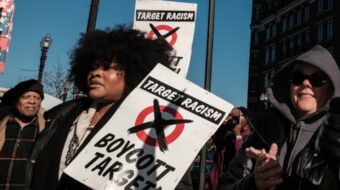
NEW YORK—On June 27 and 28, residents from two New York Community Housing Authority (NYCHA) buildings in Manhattan—Fulton Houses and Chelsea-Elliott Houses—held an emergency response rally to protest a plan to demolish their buildings and put them under private ownership.
NYCHA and the developers, Essence and Related Companies, have claimed that this decision reflects the will of the tenants, but a minority decision and the excuse of essential repairs for NYCHA are being used as a strategy to distract from the real issue: the funding and preservation of Section 9 housing.
This attack on genuinely affordable housing is an extension of a years-long battle against management companies coming into Chelsea and transforming these apartments from public to private units charging market rates.
NYCHA announced the plan on June 21, stating that the “new redevelopment…will be overseen by NYCHA and Essence Development and co-developed by Related Companies” and supposedly prioritize “the rebuilding of all the campuses’ existing NYCHA apartment buildings, as well as the redesigning of community centers and outdoor spaces, and building additional mixed-income buildings and community facilities.”

Although the plan is presented as a decision made by tenants, it is part of a long effort to transform the federally-funded housing units into mixed-income apartments, creating opportunities for privatization and opening up avenues of profit for real estate companies.
Phasing out Section 9 housing
The intention to demolish the Fulton Houses and Chelsea-Elliott Houses is a continuation of past NYCHA policies aimed at privatization and dispossession. Since 2016, the NYCHA administration and private real estate companies have used two plans to introduce market-rate apartments into federal housing: Rental Assistance Demonstration (RAD) / Initiative Permanent Affordability Commitment Together (PACT) and the Blueprint for Change Preservation Trust.
The “Blueprint for Change ” is a program intended to “stabilize” NYCHA’s funding and tackle the $40 billion backlog of repairs by creating a NYC Public Housing Preservation Trust. It hopes to do this by transitioning NYCHA from being federally-protected public housing (Section 9) into an accepted federal voucher program owned and operated by private management companies (Section 8).
As the plan states: “Each year, NYCHA only receives roughly $500 million in capital funding from Congress through Section 9, a fraction of what we need. At these current funding rates, it would take over 80 years to meet NYCHA’s capital shortfall. Despite years of advocacy, NYCHA has seen less and less money from administrations on both sides of the political spectrum. And Section 9 does not allow NYCHA to access other financing sources, such as Section 8 funds, which further limits NYCHA’s ability to address its capital needs.”
City officials thus concluded that the only possible solution for fixing the NYCHA’s buildings is via private financing.
The RAD/PACT program, introduced in 2011 by President Barack Obama, is a similar conversion program that aims to transfer public housing to private management to make needed repairs. Alongside the Preservation Trust, this program, which affects 62,000 apartments, will use management companies like Apex Building Group and Gilbane Development Company to lead the initiative and make repairs.
The ongoing attack on NYCHA
In 2019, the PACT-Chelsea Working Group was created to include tenant perspectives for the Permanent Affordability Commitment Together (PACT) program. However, through this process, instead of reflecting the needs and desires of tenants, it pushed a program of privatization, using specific tenants as mouthpieces.
The working group was only created after tenants had been fighting privatization for months. Additionally, the excuse of a backlog of needed repairs was used as the foundation to introduce the working group:
“Your development has been selected to be a part of the program. This means that your homes and community spaces will receive much-needed renovations, you will have access to employment opportunities affiliated with the repairs and on-site social services will be enhanced.”
The Chelsea Working Group is made up largely of real estate interests, not tenants. It worked closely with developers to craft a plan to privatize the apartments.
The administration at City Hall says the plan is a solution to the repair backlog but it may essentially amount to a strategy to quicken the process of privatization. As stated in the plan’s original press release, “NYCHA currently has a growing backlog of over $40 billion worth of repairs and maintenance due to aging infrastructure and decades of federal disinvestment — the results of which are evident at all NYCHA developments, including Fulton and Elliott-Chelsea Houses.”
The City and Essence see no other way of fundraising the money for needed repairs but to privatize, but some argue there are sufficient city, state, and federal funds to fix every NYCHA building and invest in needed infrastructure repairs, green spaces, and activity rooms.
There are currently over 6,000 vacant NYCHA apartments, even as individuals and families have been on the NYCHA waitlist for years and as the Section 8 housing application remains closed.
Undemocratic
Fulton and Chelsea Elliott tenants were given a form with three options to decide what course NYCHA should take to address needed repairs: 1.) Privatize via RAD/PACT; 2.) Privatize via the Preservation Trust; or 3.) Remain as Section 9 buildings—i.e. the status quo.
Tenant Association meetings have been hosted by Essence and Related Companies, with real estate developers and selected NYCHA tenants reflecting the interests of management. During the June 26 and 27 emergency rallies, tenants spoke of being unable to access the room where this important meeting took place, including on the day of the rally itself.
Tenants reported not only being forcefully locked in their rooms during the duration of the meetings but were told that these meetings were private. At the emergency rally, residents challenged what right the real estate company had to bar tenants from a meeting directly affecting them.
Darlene Waters, a tenant on the board of the Hudson Guild, the private management company initiating the program pushing privatization; Miguel Acevedo, former member of the Chelsea Working group and lead tenant in pushing the PACT privatization project; and a representative from Essence, together, used the NYPD to directly remove tenants from where the meetings were taking place.
Tenants like Andrea Patton, who has lived in Chelsea-Elliott Houses for decades, don’t believe the vote reflected the will of a majority of tenants because many were unaware a vote was occurring or, if they were aware, they didn’t know what it implied for their homes.
She said: “Some people didn’t get a chance to vote. I heard one lady say ‘I didn’t know this was happening’ and they just found out, and that’s messed up. I’ve been here for 23 years…what about the ones that raised their kids for even more years here, what will they do?”
According to Save Section 9, an organization of NYCHA tenants against privatization, only about 30% of tenants voted; of those, only about 60% of those chose demolition. That’s only about 18% of total tenants voting in favor of the plan.
In contrast, a 2019 petition against privatization was signed by 60% of heads of households at Fulton and presented to the working group. Residents are rightly distressed by the prospect that once they leave their apartments, they’ll be unable to return. Similar precedents of permanently removing tenants under cover of temporary relocations, such as in Chicago’s Cabrini Green.
Acevedo stated that they made an effort to go door to door and contact each tenant, yet tenants themselves stated that they could not make it due to disabilities and being locked in their apartments during the voting process. However, both management and the pro-management tenants see this vote as reflecting the will of all 3,000 tenants in the buildings.
Acevedo celebrated the decision, stating, “We are grateful to the hundreds of Fulton and Elliott-Chelsea residents that participated in this first-of-its-kind selection process, helping to bring NYCHA and our city’s public housing to the next generation.”
No protection from privatizers
In one building that underwent RAD, it was shown that the eviction process could proceed faster once federal protections were stripped and profit interest is introduced. As the National Low Income Housing Coalition states, “At Ocean Bay (Bayside), which houses 3,700 people, residents said that new private management was more aggressive concerning eviction. They ‘put you out faster.’”
Data from Ocean Houses indicate that “eviction rates increased in the years following conversion, and that eviction rates for both for non-payment and other reasons are significantly higher than the NYCHA average. Data for one other large conversion, Betances in the Bronx, indicate that evictions increased post-conversion.”

This sets a dangerous precedent concerning converted NYCHA properties. Instead of the company privatizing to make needed repairs as they claim, the introduction of private management has been more about stripping tenants of their fundamental rights and speeding up evictions, according to many renters.
Maribel Rodriguez, 61, has lived in Chelsea Elliott for 22 years. “They want to demolish the buildings, and they want to do that because they want to build a new building right there to put everybody in,” he said. “They say that but not everybody is going to fit because now there are too many buildings. They say, ‘We will get you an apartment somewhere else,’ but when it’s time for us to come back, we can’t. The rent prices are going to be too high. By the time they place you somewhere else and you come back for yours, you won’t be able to afford it. Why are we letting them do this to us?”
On June 21, Mayor Eric Adams, a strong supporter of private real estate, made a tweet “celebrating” the result. He said that he was happy with the decision to have the buildings move under private management and that it represented the collective decision of the tenants. He said, “We are committed to making sure residents are front and center in decision-making and to bringing new housing to NYCHA families.”
Adams has not only placed pro-developer members on the Rent Guidelines Board (RGB), resulting in increased rents throughout the city, but he has also continually defended the rights of large landlords, resulting in the stripping of tenant protections.
The Fulton and Chelsea Elliott fight is about saving public housing
The fight to save Fulton and Chelsea-Elliott Houses is part of a larger fight to save and invest in Section 9 Federal Housing. The intention to transition public housing from Section 9 (federally funded) to Section 8 (using vouchers in buildings operated by private companies) has resulted in the stripping of federally-protected public housing in the United States.
Destroying these two federally-funded buildings in Manhattan will create the opportunity for developers to use privatization schemes and zoning laws to introduce market-rate apartments everywhere.
For the tenants of Fulton and Chelsea-Elliott, their fight to stay in their homes is intertwined with the fight for all tenants to hold onto federally-protected housing. Residents in Chelsea-Elliot and Fulton see each other as one community, together in a single struggle.
As Chelsea-Elliott tenant Andrea Patton said, “Now they [the management company] want to build all of these buildings and tear ours down. No, you can’t do that. I’m at Elliot-Chelsea, but at Fulton, it’s the same thing. We’re all a community, Fulton or Elliott it doesn’t matter, we’re all together. We both come to the playground and play together; it doesn’t matter where you’re from.”
We hope you appreciated this article. At People’s World, we believe news and information should be free and accessible to all, but we need your help. Our journalism is free of corporate influence and paywalls because we are totally reader-supported. Only you, our readers and supporters, make this possible. If you enjoy reading People’s World and the stories we bring you, please support our work by donating or becoming a monthly sustainer today. Thank you!










